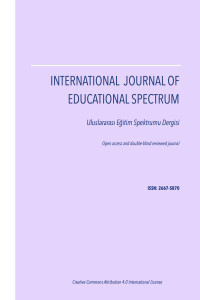SÖZLÜ SÖYLEVDEKİ YUMUŞATMA SÖZCÜKLERİNİN TÜRK ÜNİVERSİTE ÖĞRENCİLERİ TARAFINDAN KULLANIMI
Bu çalışma, Türk üniversite öğrencilerinin ifadeyi yumuşatma sözcüklerinin kullanımını işlev ve anlam bakımından araştırmıştır. Bu çalışmada kullanılan sözcükler şunlardır: 'demek istediğim','bir nevi / sayılır', 'sadece', 'gibi', 'bence', 'sanırım', 'bilmiyorum', 'bilirsin', 'bunun / veya onun gibi bir şey'. Bu sözcükler, Michigan Sözlü Amerikan İngilizcesi Derlemi (MICASE) ve Cambridge ve Nottingham İngilizce Söylev Derlemi (CANCODE) bulgularına göre en sık kullanılanlar olarak sıralanmaktadır. Bu çalışmaya Türkiye'deki büyük bir üniversitenin İngilizce Öğretmenliği bölümünden toplam 17 son sınıf üniversite öğrencisi katkıda bulunmuştur. Katılımcılara, konuşma metinlerinde yumuşatma sözcükleri hakkındaki tutum ve farkındalıklarını ortaya koymak amacıyla üç ana bölümden oluşan bir anket (Kot, 2015) uygulanmıştır. Bulgular ELT öğrencilerinin sözlü bağlamlarda yumuşatma sözcüklerinin işlevinin farkında olmadıklarını ortaya çıkarmıştır. Ancak, anketin nicel bölümünde ise hem ana dil hem de yabancı dil kapsamında sık sık kullandıklarını bildirmişlerdir. Bu, öğretmen eğitimi yaklaşımlarının pragmatik eksikliklere ışık tutabilir. Ayrıca, bu makale, ilgili literatürden yararlanarak yabancı dil öğretmeni eğitimi programları için pedagojik çıkarımlar hakkında fikir vermektedir.
Anahtar Kelimeler:
Yumuşatma sözcükleri, edimbilim, öğretmen eğitimi, Türk üniversite öğrencileri
The Use of Hedging Devices in Spoken Discourse by Turkish University Students
This research sought to investigate Turkish university students’ use of hedging as regards to the function and meaning. The devices used in this study were ‘I mean’, ‘sort of/kind of’, ‘just’, ‘like’, ‘I think’, ‘I guess’, ‘I don’t know’, ‘you know’, ‘or something/or something like that’. These are ranked as the most frequently used ones according to Michigan Corpus of American Spoken English (MICASE) and Cambridge and Nottingham Corpus of Discourse in English (CANCODE) corpora findings. A total number of 17 senior university students from the English Language Teaching (ELT) department of a major university in Turkey contributed to this study. A questionnaire developed by Kot (2015), including three main sections, was administered to the participants in order to disclose their attitudes and awareness of hedging devices in spoken texts. The findings showed that the ELT students were not actually aware of the function of hedging devices in spoken contexts although they reported to use them frequently both in L1 and L2 in the quantitative section of the questionnaire. This might refer to the deficiencies in the pragmatic aspects of teacher education approaches. Furthermore, this article provides insights into the pedagogical implications for language teacher education programs by building on the relevant literature.
Keywords:
Hedging devices, pragmatics, teacher education,
___
- Andersen, G. (1998). The pragmatic marker like from a relevance-theoretic perspective. Pragmatics and Beyond New Series, 147-170.
- Bardovi-Harlig, K. 2001. Evaluating the empirical evidence. Grounds for instruction in pragmatics? In Pragmatics in language teaching, eds. K. R. Rose and G. Kasper, 13–32. New York: Cambridge University Press
- Brown, P., & Levinson, S. C. (1987). Politeness: Some universals in language usage (Vol. 4). Cambridge university press.
- Carter, R., & McCarthy, M. (1997). Exploring Spoken English (Vol. 2). Cambridge University Press.
- De Cock, S., S. Granger, G. Leech and T. McEnery. 1998. An automated approach to the phrasicon of EFL learners. In Learner English on computer, ed. S. Granger, 67–79. London: Addison Wesley Longman.
- Flores-Ferrán, N., & Lovejoy, K. (2015). An examination of mitigating devices in the argument interactions of L2 Spanish learners. Journal of Pragmatics, 76, 67-86.
- Fraser, B. 2010. Pragmatic competence: The case of hedging. In New approaches to hedging, eds.G. Kaltenböck, W. Mihatsch and S. Schneider, 15–34. Bingley, UK: Emerald Group Publishing Limited.
- Grant, L. E. (2010). A corpus comparison of the use of I don’t know by British and New Zealand speakers. Journal of Pragmatics, 42(8), 2282-2296.
- Kot, A. (2015). It’s Small Words that Make a Big Difference. In Issues in Teaching, Learning and Testing Speaking in a Second Language (pp. 45-67). Springer Berlin Heidelberg.
- Metsä-Ketelä, M. (2006). “Words are more or less superfluous”: the Case of more or less in Academic Lingua Franca English. Nordic Journal of English Studies, 5(2), 117-43.
- Miskovic-Lukovic, M. (2009). Is there a chance that I might kinda sort of take you out to dinner?: The role of the pragmatic particles kind of and sort of in utterance interpretation. Journal of Pragmatics, 41(3), 602-625.
- Moreno, Á. E. I. (2001). Native speaker-non-native speaker interaction: the use of discourse makers. Elia: Estudios de lingüística inglesa aplicada, (2), 129-142.
- Nikula, T. 1997. Interlanguage view on hedging. In Hedging and discourse: Approaches to the analysis of a pragmatic phenomenon in academic texts, eds. R. Markkanen and H. Schröder, 188–207. Berlin: Walter de Gruyter.
- Nugroho, A. (2004). The contradiction of certainty and uncertainty in hedging and its implications to language teaching. k@ ta, 4(1), 26-34.
- Yang, Y., & Yap, F. H. (2015). “I am sure but I hedge”: Fear expression kǒngpà as an interactive rhetorical strategy in Mandarin broadcast talk. Journal of Pragmatics, 83, 41-56.
- ISSN: 2667-5870
- Yayın Aralığı: Aylık
- Yayıncı: Hakan ULUM
Sayıdaki Diğer Makaleler
İNGİLİZ DİLİ EĞİTİMİNDE AKILCI KURAMIN İNCELENMESİ
Seçenek Bolluğu Karar Verme Davranışını Nasıl Etkiler?
Yedinci Sınıf Öğrencilerinin Fen Bilimleri Konularında Dijital Öykü Hazırlama Deneyimleri
Emel ULUM, FERİDE ERCAN YALMAN
SÖZLÜ SÖYLEVDEKİ YUMUŞATMA SÖZCÜKLERİNİN TÜRK ÜNİVERSİTE ÖĞRENCİLERİ TARAFINDAN KULLANIMI
